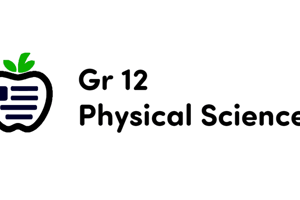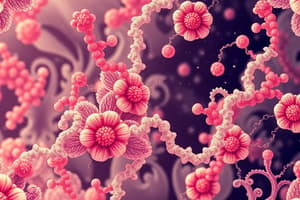Podcast
Questions and Answers
The opposite of a dehydration synthesis reaction is a hydrolysis reaction.
The opposite of a dehydration synthesis reaction is a hydrolysis reaction.
True (A)
When table salt, sodium chloride (NaCl), is placed in water ______.
When table salt, sodium chloride (NaCl), is placed in water ______.
- Na+ and Cl- become separated by their Van der Waals forces
- Na+ and Cl- form polar covalent bonds with each other
- Na+ and Cl- form hydrogen bonds with water
- Ionic bonds between Na+ and Cl- are broken (correct)
- Na+ and Cl- form ionic bonds with each other
Blood contains NaCl, protein, and cells. The NaCl is in a(n) _______, the protein is in a(n) _______, and the cells are in a(n) _______.
Blood contains NaCl, protein, and cells. The NaCl is in a(n) _______, the protein is in a(n) _______, and the cells are in a(n) _______.
- emulsion; solution; suspension
- solvent; emulsion; colloid
- suspension; colloid; solution
- solution; colloid; suspension (correct)
- colloid; suspension; solution
Flashcards
Hydrolysis reaction
Hydrolysis reaction
A chemical reaction that breaks bonds by adding water.
Ionic bonds in water
Ionic bonds in water
Ionic bonds are disrupted when substances dissolve in water.
Solution
Solution
A homogeneous mixture of two or more substances.
Colloid
Colloid
Signup and view all the flashcards
Lowest H+ concentration
Lowest H+ concentration
Signup and view all the flashcards
Decomposition reaction
Decomposition reaction
Signup and view all the flashcards
Monosaccharide
Monosaccharide
Signup and view all the flashcards
Polysaccharide
Polysaccharide
Signup and view all the flashcards
Hydrophobic molecules
Hydrophobic molecules
Signup and view all the flashcards
Covalent bonds in water
Covalent bonds in water
Signup and view all the flashcards
pH of blood plasma
pH of blood plasma
Signup and view all the flashcards
Heat capacity of water
Heat capacity of water
Signup and view all the flashcards
Acidic pH
Acidic pH
Signup and view all the flashcards
Alkaline pH
Alkaline pH
Signup and view all the flashcards
Digestion of starch
Digestion of starch
Signup and view all the flashcards
Hydrophilic molecules
Hydrophilic molecules
Signup and view all the flashcards
Protein in blood
Protein in blood
Signup and view all the flashcards
Chemical bond strength
Chemical bond strength
Signup and view all the flashcards
Blood components
Blood components
Signup and view all the flashcards
Synthesis reaction
Synthesis reaction
Signup and view all the flashcards
Dehydration synthesis
Dehydration synthesis
Signup and view all the flashcards
pH scale
pH scale
Signup and view all the flashcards
Household ammonia
Household ammonia
Signup and view all the flashcards
Acidic substances
Acidic substances
Signup and view all the flashcards
Alkaline substances
Alkaline substances
Signup and view all the flashcards
Glucose
Glucose
Signup and view all the flashcards
Starch
Starch
Signup and view all the flashcards
Hydrophobic substances
Hydrophobic substances
Signup and view all the flashcards
Hydrophilic substances
Hydrophilic substances
Signup and view all the flashcards
Digestive enzymes
Digestive enzymes
Signup and view all the flashcards
Covalent vs. Ionic bonds
Covalent vs. Ionic bonds
Signup and view all the flashcards
Study Notes
Question 4
- The opposite of a dehydration synthesis reaction is a hydrolysis reaction.
- This statement is TRUE.
Question 5
- When table salt, sodium chloride (NaCl), is placed in water, ionic bonds between Na+ and Cl− are broken.
- Na+ and Cl− form hydrogen bonds with water.
Question 6
- Blood contains NaCl, protein, and cells. NaCl is in a solution, the protein is in a colloid, and the cells are in a suspension.
Studying That Suits You
Use AI to generate personalized quizzes and flashcards to suit your learning preferences.




